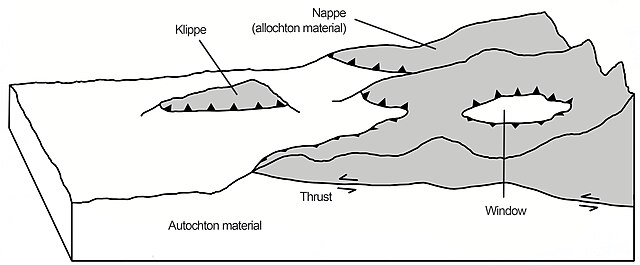The Alps form part of a Cenozoic orogenic belt of mountain chains, called the Alpide belt, that stretches through southern Europe and Asia from the Atlantic all the way to the Himalayas. This belt of mountain chains was formed during the Alpine orogeny. A gap in these mountain chains in central Europe separates the Alps from the Carpathians to the east. Orogeny took place continuously and tectonic subsidence has produced the gaps in between.
Satellite image of the Alps, March 2007
Folded rock layers exposed in the Swiss Alps
Folded Helvetic nappe rock layers at Dent de Morcles, Switzerland
In geology, a nappe or thrust sheet is a large sheetlike body of rock that has been moved more than 2 km (1.2 mi) or 5 km (3.1 mi) above a thrust fault from its original position. Nappes form in compressional tectonic settings like continental collision zones or on the overriding plate in active subduction zones. Nappes form when a mass of rock is forced over another rock mass, typically on a low angle fault plane. The resulting structure may include large-scale recumbent folds, shearing along the fault plane, imbricate thrust stacks, fensters and klippes.
Schematic overview of an eroded thrust system. The shaded material is the nappe. The erosional hole is called a window or fenster. The klippe is the isolated block of the nappe overlying autochthonous material.
Klippe of Hronic nappe, Mt. Vápeč, Strážovské vrchy Mts., Slovakia
Converging tectonic plates and the orogenic wedge






